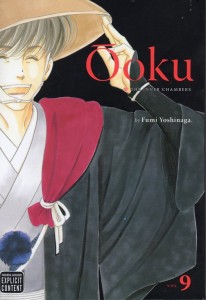Manga Review: Ooku by Fumi Yoshinaga
In an alternate history version of Japan, disaster strikes during the reign of Shogun Iemitsu (circa 1630). A plague that becomes known as the “red-face pox” sweeps the islands, with a fatality rate of 80% among boys and young men. Within a couple of years, the gender imbalance among the younger generation has reached crisis proportions. Less important to the people, but vital to our story, all the male heirs to the shogunate fall victim to the plague.
It is decided that the country, already turning topsy-turvy as young women have to take up the jobs normally reserved for men, cannot be allowed to have turmoil at the top as well. Iemitsu’s daughter Chie is forced to masquerade as her father for years. After the people who originally controlled her are dead, and the country has more or less stabilized in its new male-scarce society, she reveals herself to the court. Until a male heir survives to adulthood, women using men’s names will have to fill in.
Naturally, a female shogun needs men to help her produce an heir, so handsome and/or noble fellows are brought to the Ooku, the “Inner Chambers” in a reversal of the harems of our history. Most of the story involves these men, trapped in the Shogun’s palace, and trying to find meaning in their lives.
In the volume to hand, #9, the reign of the seventh female shogun, Ieharu, begins. Ieharu realizes that the rest of the world has advanced while the Japanese hid themselves away to conceal their lack of men. Therefore, one of the men she secures for the Ooku is a half-Dutch fellow named Gosaku, who has been trained in Western medicine. He is renamed Aonuma (“blue pond”) after his eye color.
Thanks to records concealed in the Inner Chambers, Aonuma is able to piece together information about the red-face pox and its origins that have new meaning with his special training. There might even be a way to prevent it! However, prejudice against his foreign appearance and the schemes of a woman who believes that she should have been shogun instead may doom these efforts.
This series is an interesting sideways look at Japanese history–what would change if the gender roles were partially reversed, and what would stay the same? The target audience in Japan is josei (young women), so romance both fulfilled and tragic is a large part of the series. Unfortunately, so is rape, and there’s some frank depiction of prostitution, so the American edition is rated “Mature.”
The art is quite good, but often the minor characters are hard to tell apart, particularly the handsome young men of the Ooku, who tend towards same-face. The student of Japanese history will be able to spot certain character traits from clothing styles that are lost on most of us foreigners.
I’d recommend this to historical romance fans and people interested in exploring ideas about gender roles.


Well that is certainly ‘food for thought’…..
It does raise some interesting questions about what is random chance and what is the firm result of human nature.
Over the years I’ve been lucky to visit Japan a couple of times. It is a complicated culture and this review reminds me of that fact.
Indrrf it is. I hope to visit Japan someday if my money situation improves.
I haven’t warmed up much to manga yet, though I’ve loved graphic novels since I was a kid. I might give this one a chance, though, tragic romance and, ahem, “maturity” aside. The ramifications of this alternate timeline fascinate me.
If, like many people I’ve known, have difficulty with the standard “shounen” (boy’s) manga stylings, the more sedate and delicate style of this series might work well for you. Despite the subject manner, there’s little to no nudity and no graphic sex.